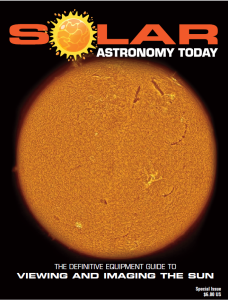For over 30 years the Observer’s Sky Atlas has been a handy guide for anyone using binoculars or a small telescope to search the sky. The latest edition from Firefly Books of the classic book (previously published only in black-and-white) has been updated with new celestial maps in full color, up-to-date data from the Gaia spacecraft and unique comparison images of a number of the most visible celestial objects.
 The Observer’s Sky Atlas is equally useful for any amateur astronomer as the beginning astronomer can easily use it to find star clusters, gaseous nebulae and galaxies throughout the night sky. Quick orientation is guaranteed, and intermediate astronomers can really enjoy the night sky for hours and hours by knowing quickly where to locate the objects of their interest.
The Observer’s Sky Atlas is equally useful for any amateur astronomer as the beginning astronomer can easily use it to find star clusters, gaseous nebulae and galaxies throughout the night sky. Quick orientation is guaranteed, and intermediate astronomers can really enjoy the night sky for hours and hours by knowing quickly where to locate the objects of their interest.
Each deep-sky object discussed has a star chart, a finder chart, a description, catalog data, an image for visual observations and a photo, all on the same double-page spread. The detailed colored charts for daytime use change into charts for nighttime use when the pages are illuminated with red light. There are sixty-one all-new star charts that are good through 2060, and there are 532 pictures of stars, galaxies and nebulae, 415 of them in full color.
In addition, this new edition contains predictions for the separation of binaries all the way to 2060 and a new section that includes images and charts for observing the Milky Way. Very detailed position figures help the astronomer navigate the charts and accurately pinpoint objects for viewing – and knowing what you’re seeing.
The Observer’s Sky Atlas will be available in May. You can learn more here.

 And to make it easier for you to get the most extensive news, articles and reviews that are only available in the magazine pages of Astronomy Technology Today, we are offering a 1-year magazine subscription for only $6! Or, for an even better deal, we are offering 2 years for only $9. Click here to get these deals which only will be available for a very limited time. You can also check out a free sample issue here.
And to make it easier for you to get the most extensive news, articles and reviews that are only available in the magazine pages of Astronomy Technology Today, we are offering a 1-year magazine subscription for only $6! Or, for an even better deal, we are offering 2 years for only $9. Click here to get these deals which only will be available for a very limited time. You can also check out a free sample issue here.
The sun is more active than it has been in years! If you’d like to learn more about the technology behind solar observing, solar imaging and more, you can check out our free publication, “The Definitive Guide to Viewing and Imaging the Sun”. You don’t have to sign up or provide any information, simply click here and enjoy reading!



